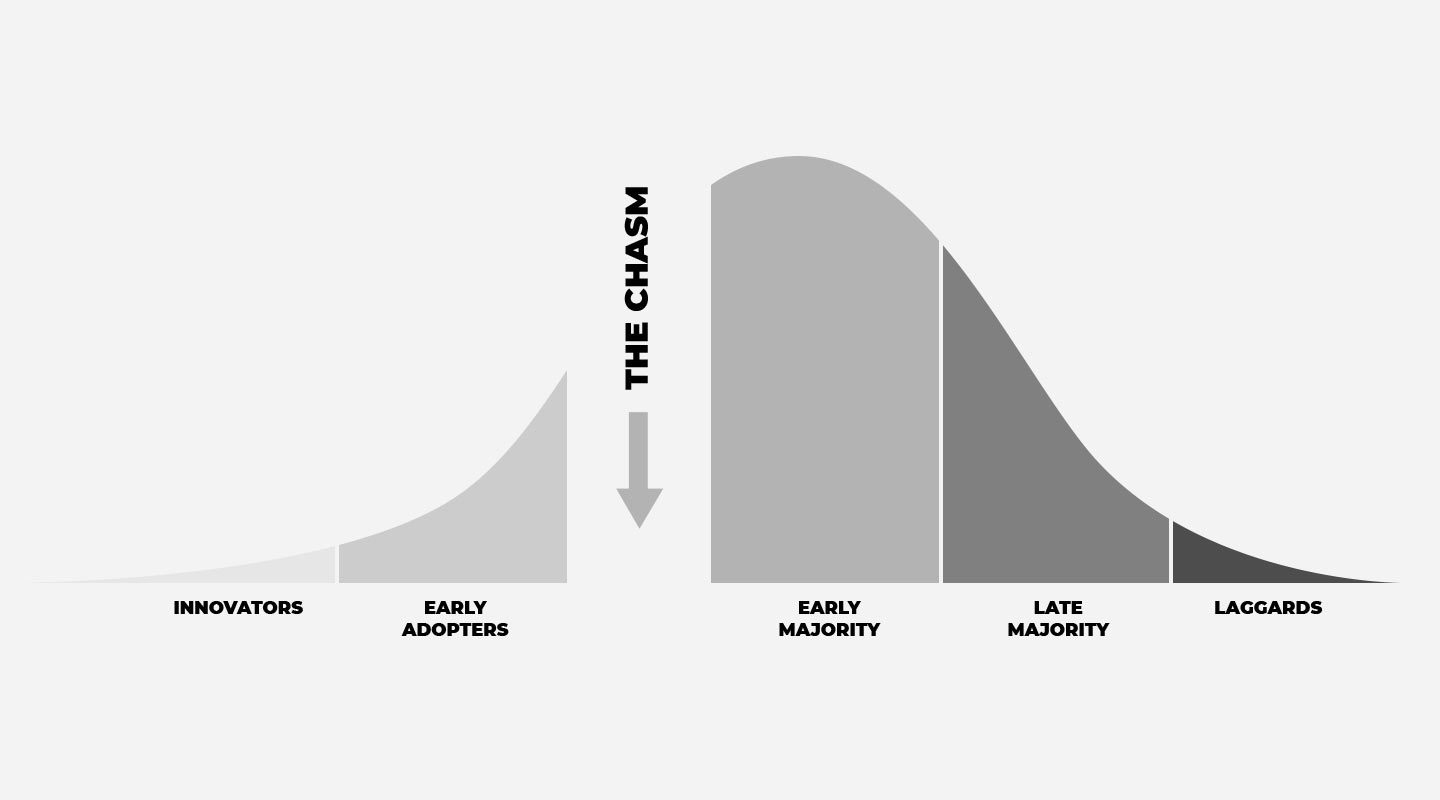10 minutes
Why Sales & Marketing Are Broken:
90% of the world has not implemented what Geoffrey Moore put forth in his “Crossing the Chasm.” Successful startups are usually comprised of a team of a technical genius (scientist/engineer/software developer), CFO, and someone to do “sales & marketing.” They invent a better mousetrap, write a white paper, and then go to trade shows to demonstrate their new product/technology.
Most startups I have observed are ‘a solution looking for a problem.’ Statistically, only 13% of the people who look at it will want to buy it. Only 13% of us are early adopters.
Innovators and early adopters think, “Son of a gun! I’ve been waiting for somebody to do this; this is exactly what I need.” So, they looked at the demo, read the white paper, and they were able to come up with their personal vision of usage, their buying vision.
As Geoffrey Moore points out in his book when most startups run out of innovators and early adopters, they hit the ‘Chasm.’ The startup thinks they’re red hot because early buyers are raving about it. But once they realize they have run out of innovators and early adopters, they now have to figure out how to market their new product to people who don’t yet know about it, don’t know why they need it, much less how they would use it to solve problems, achieve goals, make money or save money – the early majority of their potential market. They have to figure out how to “Sell to the Bell.”

Avoiding The Chasm – a Story
In the early 90s, Microsoft hit the Chasm on Microsoft Office. Initially, Microsoft Office sales soared. Then they hit the Chasm. Only 13% (at best) of their potential small business market for Office had bought. They realized they had no clue how their small business customers (retail, construction, doctor/dental, etc.) were using Office to improve their business operations.
Microsoft hired my team to ‘harvest’ stories to sell to the early majority of the Office market. We sat down with one of their favorite customers in the construction business and asked, “show me how you use Office in your business.” They answered with this specific outcome, “now we know the profitability of any job this fast.” They gave us their first “customer usage story.”
Then we asked the question, How did you do it before you had Microsoft Office? to gather the rest of the story elements:
Setting – the type of business, owners, what they are good at, etc.
Struggle – the old way they calculated job profitability before Office
New Way – ‘they want and need real-time job profitability information.‘
Resolution – business and personal results (more profits & time with kids)
With these stories, we can “Sell to the Bell” of early majority construction buyers, help them see why they need it, how they would use it, and who else has done it.
The typical tactical marketing model is product (expertise) marketing, not “customer expertise” marketing. There is no thought of (or ability to) avoiding the Chasm by writing the early majority story well. A big problem with this lack of forethought and planning is that your time in the Chasm allows your competition to enter your market.
Product marketing is so dominant in most technology companies that they don’t consider how their Early Majority customers will use their new product to solve problems, achieve goals, make money/save money.
Sadly, even in 2021, most tech companies are still pushing their products out and falling into the Chasm. (“Crossing The Chasm” was published in 1991.)
The Role of Tactical Marketing and Sales:
Both Sales and Marketing help people buy our product. Both roles initiate buy cycles. Tactical Marketing is 1 to many, and Sales is typically 1:1. There’s still peer curiosity, peer envy, connection, trust, pain, a struggle, and a buying vision.
The first step of a new buy cycle is curiosity. To do this effectively, we must facilitate peer curiosity with an offer of a peer story. The offer of a peer story stimulates curiosity and causes visceral story anticipation in most humans. The Customer Hero story brings the new suspect to peer envy. Both Sales and Marketing can use customer experience stories, aka Customer Hero stories, to facilitate new buying cycles. To integrate silos, both Sales and tactical Marketing must agree on the definition of a Qualified Lead. Our definition: a targeted buyer persona, by name, is curious how we helped their peer achieve a goal or solve a problem. Sales and Tactical Marketing get along well once they share a mutual definition of a qualified lead.
Traditional noun-oriented product training retards both onboarding time for new sales hires and the customer buying experience. It messes up both the selling and the buying by introducing too many technical features into the experience. When Product Marketing requires that new sellers learn to demo, salespeople will go out and say, “Nice to meet you. Can I show you a demo?”
The Power of Peer Envy
Peer envy gets created by customer usage stories. Customer usage stories lead potential buyers to some very emotional conclusions. Conclusions like, “this person understands how hard my job is, the person seems authentic, she has helped one of my peers solve a problem I have yet to be able to solve. I now understand how my peer solved the problem, and I have hope for a solution.”
Customer usage stories convert peer curiosity to peer envy. Peer envy emotionally motivates a person to go from ‘not looking’ to ‘looking.’ Your customer hero story can lead them to a product usage buying vision.
We know how certain ‘buyer personas’ use our product offerings (whatever we sell) to respond to specific events in their job. That critical point is where they respond so much better using our help, our offering – they know sooner, make better decisions, solve a particular problem, etc.
NOTE: B2C is a whole different animal. Peer envy is much easier to accomplish with B2C offerings. People look at the product and intrinsically want it and know how to use it. For example, Apple brings out a new iPhone, and people immediately buy it. When the iPhone first came out, it wasn’t quite that simple.
Customer Expertise Marketing ramblings
If you teach sellers to lead with their product, they will share features they don’t fully understand, and their buyers will never use. Only innovator/early adopter buyers are smart enough to see which features they can see themselves using.
The ultimate Customer Hero stories are first-person video of those customers telling their stories in less than 60 seconds. Their stories begin with their setting/background, their struggle, what they said they needed, and the results. Customer Hero stories are best delivered by the actual person who solved the problem. But, of course, you can also teach your semi-intelligent website to allow visitors to satisfy their peer curiosity by selecting their job title, their industry, a ‘menu’ of problems, their curiosity about how their peer solved that problem, and then reading a story or requesting a human-to-human conversation. Once a potential buyer is peer curious, you should only lose them if you misbehave later in their buy cycle.
We have to go out and harvest successful customer stories. Teach all your customer-facing people how to use stories to facilitate buying cycles! Create a Customer Expertise Department and confine the use of your product expertise department to pre-sales proof and post-sales implementation.
Conclusions
You haven’t nailed your Go-To-Market strategy (GTM) until you can motivate people who should be looking (but aren’t) to look.
You are not ready to go to market until you are prepared to Sell to the Bell – your early majority.
